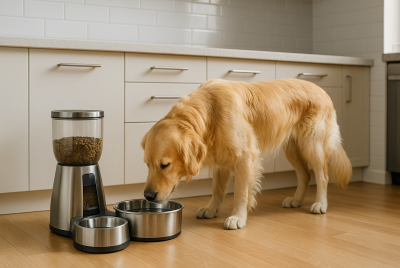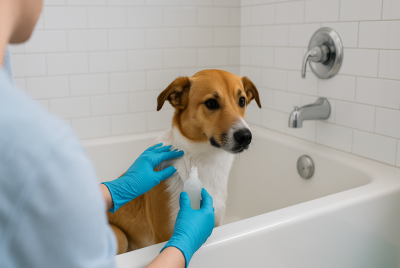Grain Free Cat Food: Best Options for Sensitive Stomachs
We may earn a commission for purchases made using our links. Please see our disclosure for more details.
You’re watching your cat do the little “hunch-and-lick” after meals again and thinking… Is it the food? If you’re exploring grain free cat food for a sensitive tummy, you’re in the right place. In this guide, we’ll talk about what “grain free” really means, who it helps (and when it doesn’t), and how to switch without drama. I’ll also share five standout products, a quick comparison table, research-backed tips, and practical, real-world advice.
What “Grain Free Cat Food” Actually Means
“Grain free” simply excludes ingredients like wheat, corn, barley, rice, and oats. Instead, these formulas often use alternatives (e.g., peas, potatoes, lentils) alongside high-protein animal sources. It doesn’t automatically mean low-carb, hypoallergenic, or better for every cat—just different.
Do Cats Need Grain Free Diets? (Pros & Caveats)
Some cats with grain sensitivities or certain GI quirks seem to do better on grain free formulas. However, many cats digest properly cooked starches just fine. The bigger picture is complete-and-balanced nutrition, appropriate protein, hydration, and portion control—not just the presence or absence of grains.
Signs Your Cat Might Benefit from Grain Free
- Frequent soft stools, gas, or post-meal discomfort
- Excessive licking, mild itch, or dull coat (after your vet has ruled out parasites, fleas, etc.)
- You’ve tried a standard “sensitive stomach” or limited-ingredient diet with partial success and want another option
Quick gut check: If symptoms are moderate to severe, or include weight loss, vomiting, or lethargy—loop your vet in first.
Key Ingredients to Look For (and Avoid)
Protein that leads the label
Aim for real animal proteins first (chicken, turkey, salmon, venison). Higher moisture or wet options can be a plus for sensitive stomachs.
Smarter carb substitutes
Look for moderate use of pea, potato, or lentil—but remember, grain free doesn’t mean carb free. Balance is key.
Gentle extras, fewer fillers
Added omega-3s, prebiotics, and probiotics can help. Avoid long lists of unnamed “by-products” or ambiguous additives if your cat is ingredient-sensitive.
Wet vs. Dry: Which Helps Sensitive Stomachs?
Wet foods add hydration and can be easier to digest for some cats. Dry foods are convenient and crunch-friendly for dental engagement. Many households use a hybrid: wet for hydration and palatability, dry for grazing and variety.
A Gentle Food Switch (No Upset Bellies)
Go slow over 7–10 days:
- Days 1–3: 25% new / 75% old
- Days 4–6: 50% / 50%
- Days 7–10: 75% / 25% → then 100% new
If stools loosen, hold at the current mix for a day or two before moving on.
Portion Sizes, Feeding Frequency, and Hydration
- Use the bag/can chart as a starting estimate; adjust to body condition.
- Split meals (e.g., morning/evening) to reduce GI load.
- Encourage water: a fountain, multiple bowls, or wet-food toppers can help.
Vet Talk: When to Seek Professional Guidance
If you’re seeing persistent vomiting, diarrhea, unexplained weight loss, or skin issues, talk to your veterinarian. Cats with chronic GI disease may benefit from limited-ingredient or hydrolyzed protein diets (therapeutic options require vet guidance).
🧪 Research at a Glance: What Studies Say
- A 2025 peer-review notes grain-free diets can offer potential benefits (e.g., palatability) yet also carry risks and unknowns, and the absence of grains does not equal “hypoallergenic.” Grain-free formulas have been scrutinized especially in dogs for possible DCM links; evidence in cats is less clear but evolving.
- Moisture matters. Evidence indicates higher moisture intake supports healthy hydration and urine output in cats; wet food or adding water can increase total water intake compared with dry alone.
If you also have a pup at home, you might enjoy our quick guide to frozen dog treats for enrichment on hot days—nice enrichment for multi-pet households.
How We Picked These Products (Scoring Criteria)
- Protein-forward: named animal proteins first
- Digestibility & simplicity: fewer ambiguous additives
- Reputation & transparency: clear ingredients and feeding guidance
- Practicality: availability, bag sizes, and feeding flexibility
- Real-world fit: options for indoor cats, picky eaters, and sensitive stomachs
Our Top 5 Picks (Amazon-Available)
Tip: Each pick below is grain free cat food, chosen for different use cases. If your cat is mid-transition or very picky, mix a spoon of the new food into something they already love and build up gradually.
1) Instinct Original Grain-Free Dry Cat Food, Real Chicken (Raw-Coated Kibble)
Why it’s popular: High animal-protein, kibble coated with freeze-dried raw for aroma and taste. Great for cats who love crunchy textures but need a protein-forward diet.
Features: Raw-coated kibble; grain-free; chicken first.
Pros: Palatable; protein-dense; multiple bag sizes.
Cons: Rich; transition slowly for sensitive tummies.
Best for: Active adults, picky cats who perk up for “raw-coated” flavor.
Review snapshot: Cat parents often note improved enthusiasm at mealtime; occasional reports of too-rich transitions—go slow.
2) Taste of the Wild Rocky Mountain Feline (Roasted Venison & Smoked Salmon) – Dry
Why it’s popular: Distinct proteins (venison & salmon) and species-specific probiotics for digestion.
Features: ~42% protein; omega blend; all-life-stage formula.
Pros: Flavor variety; good option for cats bored with chicken.
Cons: Contains pea/potato—monitor if your cat is pulse-sensitive.
Best for: Indoor cats needing palatability and a protein boost.
Review snapshot: Fans mention shiny coats and good stool quality; a minority of very picky cats prefer poultry flavors.
3) Wellness CORE Grain-Free Original (Turkey & Chicken) – Dry
Why it’s popular: Protein-focused nutrition designed by pet nutritionists and veterinarians; widely recommended in sensitive-stomach conversations.
Features: High protein; omega-3 & -6; added probiotics.
Pros: Balanced, transparent formulation; indoor options available.
Cons: Flavor can be strong for super-picky cats—sample size first if possible.
Best for: Cats needing a steady, well-rounded grain-free daily diet.
Review snapshot: Common praise for coat and appetite; occasional notes about gradual transition needs.
4) Blue Buffalo Wilderness Adult Salmon – Grain-Free Dry
Why it’s popular: Deboned salmon leads, with sweet potatoes and antioxidant fruits (cranberries, blueberries).
Features: High-protein salmon; no grains; multiple bag sizes.
Pros: Salmon-first formula; widely available.
Cons: Fish-first diets can be aromatic—store in airtight containers.
Best for: Salmon-loving cats; pet parents who want easy availability.
Review snapshot: Loved for flavor variety beyond chicken; a few cats prefer poultry-first diets.
5) Tiki Cat Born Carnivore Chicken & Fish Luau – Grain-Free Dry
Why it’s popular: Baked kibble with high animal-protein focus, designed to mimic a carnivore-leaning profile.
Features: Chicken, herring & salmon meals; available in multiple bag sizes.
Pros: Protein-rich; often a good fit for picky texture-seekers.
Cons: Premium price; transition slowly for sensitive cats.
Best for: Protein-hungry cats who enjoy crisp, baked kibble.
Review snapshot: Owners highlight mealtime excitement; occasional feedback about price per pound.
Note: All five are available on Amazon; choose bag sizes that match your cat’s pace so food stays fresh.
Quick Comparison Table
| Model | Key Spec(s) | Warranty | Approx Price/Tier | Best For |
| Instinct Original (Chicken, Raw-Coated) | Grain free; raw-coated kibble; chicken first | Manufacturer satisfaction policy (retailer-dependent) | $$ | Picky eaters; protein-first diets |
| Taste of the Wild Rocky Mountain (Venison & Salmon) | ~42% protein; species-specific probiotics | Manufacturer satisfaction policy (retailer-dependent) | $$ | Indoor cats; poultry-averse cats |
| Wellness CORE Original (Turkey & Chicken) | High protein; omegas; added probiotics | Manufacturer satisfaction policy (retailer-dependent) | $$ | All-rounder for daily feeding |
| Blue Wilderness Salmon (Adult) | Salmon first; antioxidants from fruits | Manufacturer satisfaction policy (retailer-dependent) | $–$$ | Salmon fans; easy availability |
| Tiki Cat Born Carnivore Chicken & Fish Luau | Baked kibble; high animal-protein | Manufacturer satisfaction policy (retailer-dependent) | $$$ | Premium protein focus & texture |
Approximate price tiers: $ = budget, $$ = mid-range, $$$ = premium. Always compare per-pound pricing.
Which One Should You Choose? (By Scenario)
- Sensitive stomach + picky eater: Start with Instinct Original—the raw-coating helps aroma. Add a tablespoon as a topper first.
- Chicken fatigue: Try Taste of the Wild Rocky Mountain (venison & salmon) for a different flavor profile.
- Daily driver for most households: Wellness CORE Original balances protein, omegas, and probiotics.
- Fish-first fans: Blue Wilderness Salmon fits cats who crave seafood profiles.
- Protein maximalists: Tiki Cat Born Carnivore shines for baked-kibble texture and animal-protein focus.
Real-World Tips from Multi-Pet Households
- Feed on a schedule in separate zones to avoid bowl swapping.
- Introduce one change at a time—food, then litter, then treats—so you can pinpoint what helps.
- Keep a tiny “food diary”: brand, flavor, portion, stool notes. Patterns appear fast.
Budget vs. Premium: Where to Spend
Spend on protein quality and digestibility first. Save by:
- Choosing the right bag size (freshness > bulk deals)
- Buying multi-packs or subscribe-and-save after you’ve confirmed tolerance
- Using wet food as a topper rather than full cans if you’re budget-balancing
Storage, Freshness, and Safety
- Keep dry food in its original bag, placed inside an airtight container (for fat oxidation and aroma retention).
- For wet food, cover leftovers, refrigerate right away, and use within 24–48 hours.
- Wash bowls daily—especially for cats with sensitive skin or GI issues.
FAQs
Is grain-free cat food the right choice for every cat?
Not necessarily. It can help some sensitive stomachs, but many cats do fine with carefully cooked grains. Focus on overall nutrition, protein quality, hydration, and what your individual cat tolerates.
Are grain-free diets also low in carbs?
No. Many grain free recipes use pea, potato, or lentil as carb sources. Check the ingredient list and guaranteed analysis to compare carb levels.
Can grain-free diets lead to heart issues in cats?
The strong DCM signal relates mainly to dogs; feline evidence remains limited and mixed. If you’re concerned, ask your vet and choose a reputable brand with clear nutrition credentials.
Should I choose wet or dry for a sensitive stomach?
Try adding wet food or water to meals to boost hydration, which may support urinary health—many cats simply drink more when moisture is in the bowl.
How long until I see results after switching?
Most cats show changes in 1–3 weeks. Transition slowly, keep portions consistent, and note any stool/behavior changes. If issues persist, consult your vet.
Final Thoughts: Happy Tummies, Happy Cats
You don’t have to overhaul everything overnight. Start small: pick a protein-first grain free cat food that matches your cat’s taste, transition gently, and watch for those little wins—calmer tummies, shinier coats, and more relaxed post-meal naps. You’ve got this, and your cat will thank you with a contented loaf and a slow blink.



